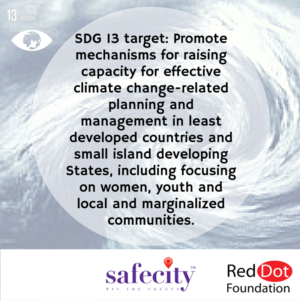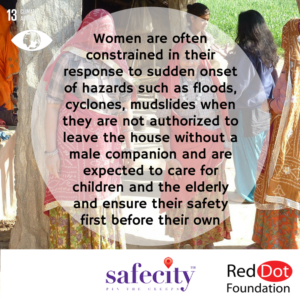Women- Affected by Climate Change yet Effective in Climate Action

Renita Siqueira is a Communications Officer at Safecity. She has completed her Bachelors in Mass Media from Mumbai. Finding joy in the little things of life, art, craft and fabric painting are some of the things she loves. A fervent reader since childhood, she finds solace in listening to music and penning down her thoughts and hopes to make a difference. http://ren-creations.blogspot.
Women- Affected by Climate Change yet Effective in Climate Action
When the earth first came into being, a Utopian and idyllic atmosphere and relationship existed between humans and nature. Nature catered to our basic needs and humans reciprocated by nurturing nature.
Unfortunately, with the passage of time, humans have exploited and depleted the earth of its natural and conventional resources and caused it much harm. Gandhiji had once said, “The earth has enough for everyone’s need, but not for everyone’s greed.”
The need for SDG 13- Climate Action–
The world today has progressed in leaps and bounds but at a tremendous cost to humankind. Progress is a double-edged sword. Though it has brought us comforts and luxuries and unimaginable benefits, it has also caused us to ring our own death knell. Industrialization, mining, shipping and other activities that we have undertaken to make our lives easier is slowly turning the earth into an oven. The greenhouse gases and black carbon released from these activities have gone way beyond the earth’s tolerance level. The earth has heated at a rapid rate of nearly 0.113°C per decade from the years 2000-2014- the Intergovernmental Panel on Climate Change reported. Hence, it was the need of the hour for world leaders to take cognizance of this dire situation and have a mutual understanding while coming to a workable solution to save the environment at the Paris Agreement 2015 also known as COP 21– the 21st session of the Conferences of the Parties where the SDGs i.e. the Sustainable Development Goals came into place. SDG 13 talks about Climate Action.
Effects of climate change–
We need to realise that climate change is no longer in the future, it is here and now. The ever increasing temperature, melting ice caps, increasing sea levels are dangerous to both humans and wild life. Intensified recurrences of storms, droughts, famines, floods and natural disasters are not just coincidences. These effects have the maximum impacts on women, children and the poorer sections of society because they lack the ways and means of combating it. They do not have the necessary resources for mitigation, adaptation and building resilience which are some of the main targets outlined in the SDG 13 Goal.
India is a developing country comprising of more rural areas than urban. The standard of living in these rural areas is not optimal and people there are at higher risk to climate changes because they are more dependent on natural resources for their daily sustenance. Unlike life in urban areas, where amenities are practically at our doorstep, people in rural areas have to collect their own water, food and fuel from the environment they live in. Deforestation, changing rainfall patterns, soil degradation affect the farmers the most. Decisions like building dams, cutting down forested area and relocation due to developmental projects have adverse impacts on them which usually go unnoticed by higher authorities. Natural disasters are much more devastating to these vulnerable sections than they are to us.
Though everyone is bearing climate change, its effects are skewered negatively towards women. “We think that you can’t attain sustainable development without gender equality,” said Eleanor Blomstrom, the program director at the Women’s Environment & Development Organization. It is necessary to come up with gender-sensitive strategies to ensure that women get the help they need to respond to the environmental and humanitarian crises caused by climate change.
Impacts of climate change on women–
Water is one of the major areas of concern for women in particular. Depending on this natural resource for most of their daily needs, rural women have to walk miles daily to fetch water. Due to scarcity, sometimes they have to survive on just one bucket a day. The repercussions of water scarcity on women and girls are much more as the problem of sanitation arises. Lack of good sanitation leads to health problems leading to lower immunity in turn resulting in an increase in deaths. There are cases where the groundwater is contaminated with arsenic and increased flood levels intensify the rate of exposure. This exposure causes numerous health problems like lesioning, hardening of skin, dark spots on their hands and feet, swollen feet and loss of the sense of touch. The villagers not only suffer from these health problems but also from their social consequences. Arsenic poisoning leads to disfiguration which gives rise to social stigma. Women bear a heavier burden as disfiguration lessens their chances of marriage leaving them more vulnerable to poverty, discrimination and being shunned from society.
Another reason why women are more vulnerable to climate change is both shocking and dismaying. Even in the 21st century women do not have equal access to resources, especially tribals and villagers who are unaware of their rights. They do not have an equal part in the decision-making process and are highly underrepresented as a part of the population at all levels. They have limited mobility and are dependent on others. Women are faced with difficulties like general accessibility of financial resources, capacity-building activities and technologies due to numerous socio-economic and political barriers. These barriers limit their ability to contribute and implement solutions and apply their expertise. Pressure to access scarce resources is correlated with increases in rape, domestic abuse, and other forms of violence against women. They are forced to migrate in search of areas that are safer with sufficient resources. This relocation and migration increases social disruption triggering more violence. Unaware of their rights, they continue living with the abuse and harassment. Vandana Shiva, says that as an ecofeminist, she sees these two movements as interconnected and believes that the worldview that causes environmental degradation and injustice is the same worldview that causes a culture of male domination, exploitation, and inequality for women.
Women leading the way for climate action–
In spite of these difficulties, it is heart-warming and inspiring that women are taking a step forward in combating climate change and even emerging as leaders. Women have the knowledge and expertise that can be used in climate change mitigation, disaster reduction and adaptation strategies. Women’s responsibilities in households and communities give them a practical understanding of innovation and skills to adapt to changing environmental realities as well as to contribute to the solution. For example, women in a village of Siri, in Karnataka, participate in Malnad Mela, a seed saving collective of women farmers. The Malnad Mela is an opportunity for these women to share traditional ecological knowledge about saving flood-resistant indigenous seeds, promote tuber cultivation as a solution to climate-induced food insecurity, engage a larger market to sell produce, and take part in leadership skills-building with other local women leaders.
It is important that the rights of rural women are ensured in regards to food security, equal access to resources and participation in decision-making processes. A report by the United Nations Population Fund and Women’s Environmental & Development Organization stated, “As innovators, organizers, leaders, educators and caregivers, women are uniquely positioned to help curb the harmful consequences of a changing climate and identify the most effective solutions.” Indigenous women leaders are working hard to safeguard their communities and homelands from industrial and commercial encroachment.
If we hope to re-establish a harmonious relationship with the environment once more, it is of utmost importance that we undertake gender-sensitive measures to protect our women, ensure equal rights as well as pay heed to their voices leading the path to climate action.




